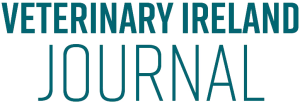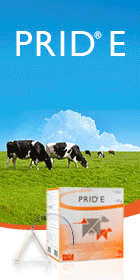Dairy cow lameness – a significant challenge
Ger Cusack MVB MRCVS Cert DHH, Greenway Agritraining and Muireann Conneely, MVB PhD, Teagasc explore lameness in the dairy cow
Lameness is a painful disease that impacts a cow’s ability to move normally and is a major welfare challenge within the dairy sector worldwide. A recent Teagasc study found that at any given time, 10 per cent or one in ten dairy cows on the surveyed farms were lame. The worst performing 20 per cent of dairy farms in the study had a lameness prevalence of 15 – 32 per cent percent (Brown et al, 2022) This study demonstrates that lameness is a significant problem on many dairy farms in Ireland.
Lameness in dairy cows is a clinical sign of a number of different conditions, rather than a disease in itself. The vast majority of lameness conditions involve the foot, with the lateral claw of the hind leg and the medial claw of the foreleg most commonly affected, due to the importance of these as the primary weight-bearing claws. While upper limb injuries do occur, these injuries cause a small proportion of the lameness cases seen on Irish dairy farms.
What are the impacts of lameness?
Lameness in dairy cows is important for a number of reasons.
It is one of the most economically-costly diseases affecting Irish dairy herds, with recent estimates placing the cost per case of lameness as high as €536 for severe lesions such as sole ulcers (Conneely and Ryan, 2024). This figure includes both direct costs, (such as treatment, veterinary call-out, labour, and reduced milk yield) as well as indirect costs (associated with increased culling risk, longer calving intervals, and reduced fertility). For example, milk yield losses alone can amount to approximately €90 per case, with a further €105 due to extended calving intervals and €168 in lost value from increased culling risk. Even for less severe conditions such as white line disease or digital dermatitis, estimated costs are €227 and €201 per case, respectively. When modelled across a 100-cow herd with moderate 10 per cent lameness prevalence, total losses can exceed €8,500 per year, underscoring the financial, as well as welfare, imperative to reduce lameness on farm.
Lameness is a painful disease and a significant welfare problem for dairy cows. It affects a cow’s ability to move normally and changes her behaviour. Animal welfare is an issue of growing concern for consumers of dairy products and society in general. Improving dairy cow welfare by reducing lameness is critical to retain societal support for dairy farming.
A high prevalence of lameness in a dairy herd can be very frustrating and have a very negative effect on morale among those looking after the cows.
Lameness impacts sustainability. It results in increased greenhouse gas emissions, due to the culling of cows at a younger age. Shorter productive lifespans means that more cows are required to produce the same volume of milk. With the environmental implications of dairy farming increasingly coming under the spotlight, it is critical that every step is taken to reduce the carbon footprint of dairy production.
Lameness increases antibiotic use on dairy farms. Even though most cases of lameness do not require antibiotic treatment, many farmers use antibiotics when treating lame cows. There is an urgent need to reduce antibiotic use in food-producing animals because of the growing problem of antimicrobial resistance.

Figure 1: White line disease lesion.

Table 1: Common disease conditions causing lameness in Irish dairy cows.
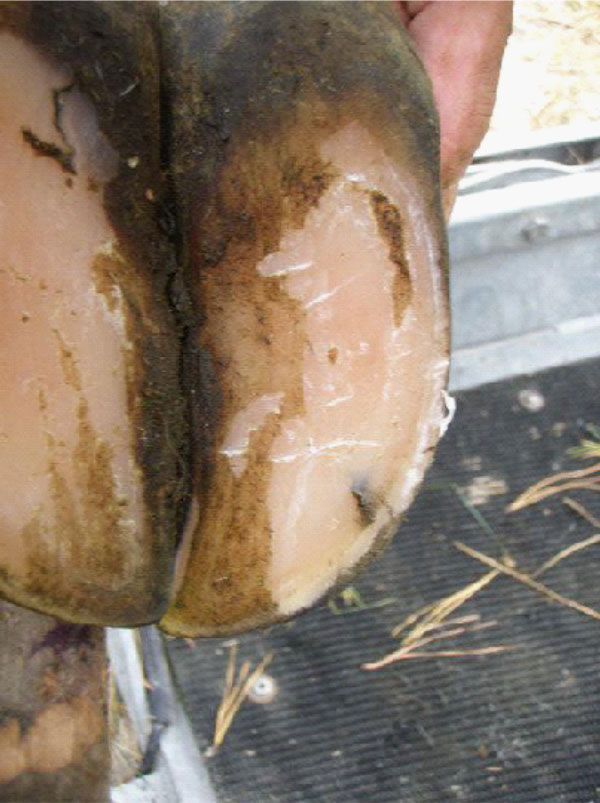
Figure 2: White line disease lesion.
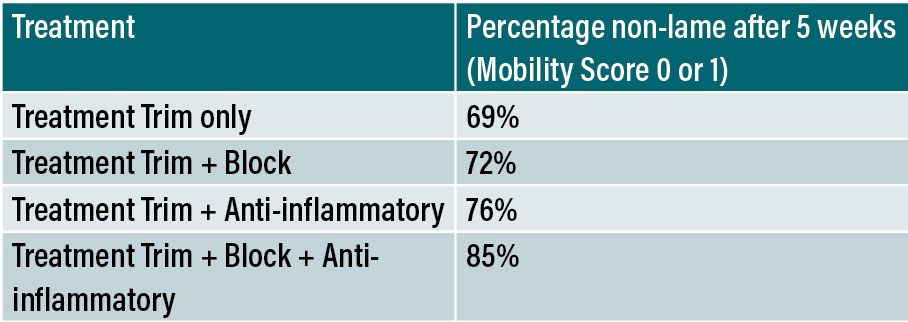
Table 2: Effect of different lameness treatment strategies on recovery rates after five weeks (Thomas et al, 2015).
Types of lameness: infectious and non-infectious causes
Foot disorders can be divided into two main categories: non-infectious, (including white line disease, sole haemorrhage/bruising, and sole ulcers) and infectious (including digital dermatitis/Mortellaro, interdigital dermatitis, and foul-in-the foot).
Non-Infectious conditions causing lameness
Non-infectious or mechanical lameness occurs largely as a result of trauma or put simply, ‘wear and tear’ to the hoof structure. In grazing herds, white line disease and sole haemorrhage/bruising are the most common hoof lesions. Sole ulcers also occur and are more prevalent in higher-yielding herds and less prevalent in Jersey cross herds.
How should non-infectious lame cows be treated?
When deciding how best to treat non-infectious hoof conditions such as white line disease, sole haemorrhage, or sole ulcer, the results of a study carried out at Nottingham University (Thomas et al, 2015) are worth noting.
This study involved examining and treating 167 cows that had become lame within the preceding two weeks (AHDB Mobility Score 2 or 3, on a scale from 0 to 3, with 0 being 100 per cent sound and Mobility Score 3 being significantly lame). All these cows suffered from claw horn lesions such as white line disease, sole haemorrhage/bruising, or sole ulcer. Cows with digital dermatitis (DD) and foul-in-the-foot were excluded.
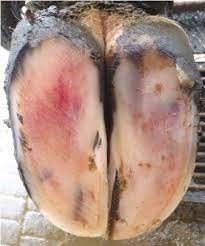
Figure 3: Sole haemorrhage/bruising.
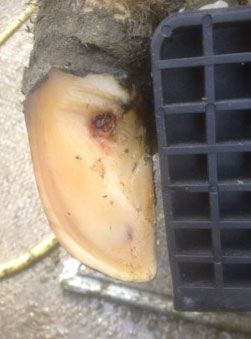
Figure 4: Sole ulcer.
The application of a block to the sound claw has clear benefits. It gives the cow immediate pain relief by taking pressure and concussion away from the affected claw. Blocks are particularly helpful during the grazing season. Cows that are lame graze for shorter times, have reduced dry matter intake, have reduced milk yield, and lose body condition. The application of a block to the sound claw mitigates these effects and, in many cases, enables the affected cow to remain part of the main herd.
The hooves of cows that are affected by conditions such as white line disease, sole bruising, or sole ulcer, suffer damage to not only the horn capsule, but also the deeper tissues. These include the corium, the laminae, and the pedal bone. The addition of non-steriodal anti-inflammatory (ketoprofen x three days) reduces the inflammatory effect and may reduce the longer-term damage that occurs in these deeper tissues.
If we regard a mobility score of 0 or 1 as a cure, in this study (Thomas et al, 2015) of recently lame (≤ 2 weeks) cows, the cure rate was in the range 69-85 per cent.
In a further study, the same researchers selected cows with Mobility Score 2 or 3 that had been lame for at least four weeks or longer (Thomas et al, 2016). The same treatment protocols were employed as the group in the first study.
The findings in this group were in stark contrast to the first study. Defining cure as a cow returning to Mobility Score 0 or 1, the cure rate in this group was extremely low. This was true in the case of all four treatment protocols.
The results of both these studies clearly demonstrate that early detection and prompt treatment of lame cows greatly improves treatment outcomes.
To achieve good treatment outcomes when treating lame cows, they need to be treated early in the course of the lameness condition. To quote Roger Blowey MVB MRCVS, recognised expert in the field of lameness: “a lame cow is an emergency and needs to be treated as such”.
Infectious conditions causing lameness
Digital dermatitis (DD; also known as Mortellaro) is a bacterial infection affecting the skin in the region of the hoof. It causes an extremely painful erosion of the skin, resulting in flat, strawberry-like lesions that can be up to five centimetres in diameter. In addition, the DD bacteria also have the capacity to infect the deeper tissues of the foot where the integrity of the horn capsule is breeched (e.g., white line disease and sole ulcer). The presence of such infections in white line disease and sole ulcer lesions slows healing and can result in non-healing lesions and poor treatment outcomes.
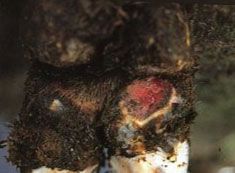
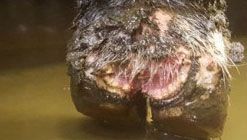
Figure 5: Two images of Mortellaro/digital dermatitis.
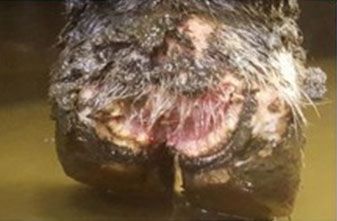
Figure 6: Digital dermatitis/Mortellaro.
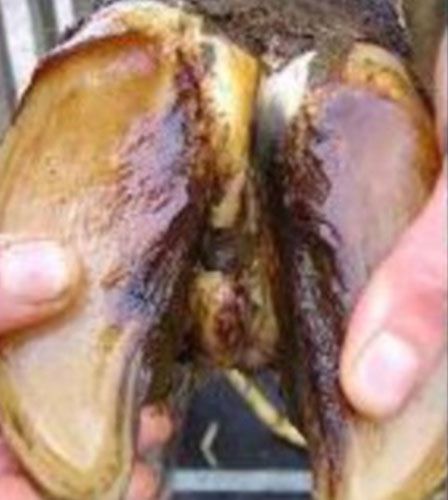
Figure 7: Foul-in-the-foot.
This condition is contagious, and if left unnoticed and unchecked, has the potential to spread rapidly through a herd. While cows are indoors, the risk of DD causing cows to go lame significantly increases. When cows are at pasture, we tend to see sporadic or occasional cases of DD. In contrast, when cows are housed, we can see outbreaks of this condition. This often happens when cows are dry and not observed daily.
The treponeme bacteria that cause DD are very active, spiral-shaped, motile and, therefore, slurry provides them with the perfect way to spread. However, they only survive in slurry for a relatively short period of time (less than 24 hours at 17o C). Slurry acts as a short-term transmission medium rather than a long-term reservoir of infection.
DD-causing treponeme bacteria bury into the skin and encyst and, even if treated early, cattle are unlikely to be cured, and will instead harbour the bacteria within a dormant lesion, which is at risk of recurring. Thus, the DD lesions themselves are the main reservoir of infection, shedding bacteria into the environment. Many apparently “cured” cows will become DD carriers. This is important to remember when it comes to implementing control strategies on farm.
Preventing the spread of infectious lameness
The purpose of walking cows through a foot bath containing a disinfectant is to reduce the level of infection (both DD and foul-in-the-foot causing infections) on the cows’ feet and in their environment. It is important to note that foot bathing is not a treatment. Foot bathing as an infection control measure is analogous to the role of teat dipping/spraying in the control of contagious mastitis. The aim of both procedures is to reduce the level of infection in the environment thus reducing the risk of new cows becoming infected.
If DD is diagnosed in a cow herd, it is important that control measures are put in place to reduce the number of new infections appearing. Spot treatment of DD lesions by spraying may cure the lesions, but many cows may be affected unless control measures to limit the spread of the disease are adopted.
Foul-in-the-foot (Interdigital Necrobacillosis) is a condition that occurs sporadically, but occasionally clusters of cases are seen. As this is an infectious condition, control measures similar to those described for DD can be implemented.
These measures include:
Early detection and prompt lifting and treating of lame feet. Affected feet should be cleaned, dried with paper towel, and sprayed with oxytetracycline spray daily for two-to-five days. This treatment will cure the vast majority of Mortellaro lesions. The application of a bandage, incorporating a topical antibiotic and/or an antibacterial gel (usually containing chelated zinc and copper) may also be effective. Note: a bandage should be removed within two days of application. Cows should not be foot bathed while being treated.
Regular foot bathing with an appropriate foot bath disinfectant product (up to four-to-six times per week may be necessary when infection levels are high). When the number of new infections drops, the frequency of foot bathing may be reduced, but because of the presence of DD carrier animals within the herd, regular foot bathing (one-to-two times per week) all year round should be continued as a long-term control measure. Constant monitoring is required and should the number of new DD infections increase, foot bath frequency would need to be increased to counteract increased infection levels.
Running scrapers as often as possible.
Cleaning up yards and passageways to prevent cows walking through banked up slurry.
Keeping young stock (weanlings and replacement heifers) away from contact with slurry from cow herd.
It is also important to state that there is no scientific evidence to support the widespread belief that foot bathing with formalin or anything else hardens hooves. The benefits of foot bathing are limited to the control of infections such as DD and foul-in-the-foot.
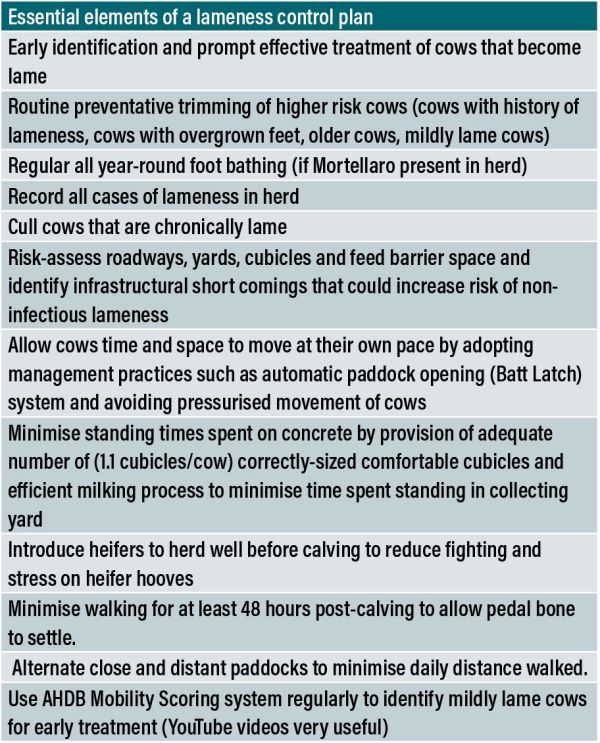
Table 3: Essential elements of a lameness control plan.
Risk factors for lameness
While specific hoof lesions are responsible for causing lameness, these lesions typically develop as a result of underlying predisposing risk factors related to the cow’s environment, management, nutrition, and physiology. Poor infrastructure, such as rough roadways, inadequate cubicles, or overcrowded collecting yards, increases the risk of trauma to the hoof and prolongs standing times. Suboptimal management practices, including poor handling, delayed detection of lameness, and lack of routine mobility scoring or footbathing, contribute to both non-infectious and infectious lameness. Nutritional issues, such as low body condition score and the rapid introduction of concentrates, can weaken hoof integrity and increase susceptibility to hoof lesions. Additionally, certain animal-level factors like early lactation, a history of previous lameness, older age, or a high genetic susceptibility can further elevate risk. Addressing these factors is essential for effective lameness prevention on Irish dairy farms.
Importance of a lameness control plan
Lameness is a complex, multifactorial issue that won’t resolve on its own. Without a structured approach to prevention and management, the problem often goes unnoticed until it becomes severe, by which time recovery is slower, costs are higher, and cow welfare is compromised. A lameness control plan helps ensure early detection, effective treatment, and long-term prevention by bringing together the key elements of good infrastructure, management, and monitoring. Most importantly, it provides a framework to protect both herd health and farm profitability.
Browne, N., et al. (2022). Cow- and herd-level risk factors for lameness in partly housed pasture-based dairy cows. Journal of Dairy Science 105(2):1418–1431.
Conneely, M., and Ryan, E. (2024). The cost of lameness in Irish dairy herds. Veterinary Ireland Journal 14(4):217–222.
Thomas, H. J., et al. (2015). Evaluation of treatments for claw horn lesions in dairy cows in a randomized controlled trial. Journal of Dairy Science 98(7):4477–4486.
Thomas, H. J., et al. (2016). Recovery of chronically lame dairy cows following treatment for claw horn lesions: a randomised controlled trial. Veterinary Record 178(5):116–U154.
1. Which of the following statements is true in relation to financial losses associated with dairy cow lameness?
- The cost per case of a sole ulcer can be as high as €536
- Milk yield losses alone per case of sole ulcer can amount to approximately €90 per case
- In a 100-cow herd with moderate 10 per cent lameness prevalence, total losses can exceed €8,500 per year
- All of the above.
2. Which of the following lameness causing conditions are non-infectious?
- Digital dermatitis (Mortellaro)
- White line disease
- Sole bruising
- All of the above
3. Which of the following statements are true?
- The treponeme bacteria that cause digital dermatitis (Mortellaro) can survive up to six months in slurry
- The treponeme bacteria that cause digital dermatitis (Mortellaro) survive for a relatively short time (less than 24 hours at 17oC) in slurry
- Infected “carrier” cows are the main reservoir of DD infection within a herd
4. How should digital dermatitis lesions be treated?
- By walking cows through a foot bath with an appropriate disinfectant reagent added
- By lifting, cleaning, drying with paper towel, and spraying with oxytetracycline spray for two-to-five days
- Parenteral injection with oxytetracycline
5. Which of the following measures are required for control of digital dermatitis in a dairy herd?
- Regular all year-round foot bathing
- Maintaining a clean environment
- Prompt treatment of cows with digital dermatitis
- Keeping young stock away from contact with slurry from the cow herd
- All of the above
ANSWERS: 1D; 2B and C; 3B and C; 4B; 5E.
